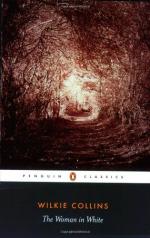Foiled at all points, but still not able to rest, Miss Halcombe next determined to visit the Asylum in which she then supposed Anne Catherick to be for the second time confined. She had felt a strong curiosity about the woman in former days, and she was now doubly interested—first, in ascertaining whether the report of Anne Catherick’s attempted personation of Lady Glyde was true, and secondly (if it proved to be true), in discovering for herself what the poor creature’s real motives were for attempting the deceit.
Although Count Fosco’s letter to Mr. Fairlie did not mention the address of the Asylum, that important omission cast no difficulties in Miss Halcombe’s way. When Mr. Hartright had met Anne Catherick at Limmeridge, she had informed him of the locality in which the house was situated, and Miss Halcombe had noted down the direction in her diary, with all the other particulars of the interview exactly as she heard them from Mr. Hartright’s own lips. Accordingly she looked back at the entry and extracted the address—furnished herself with the Count’s letter to Mr. Fairlie as a species of credential which might be useful to her, and started by herself for the Asylum on the eleventh of October.
She passed the night of the eleventh in London. It had been her intention to sleep at the house inhabited by Lady Glyde’s old governess, but Mrs. Vesey’s agitation at the sight of her lost pupil’s nearest and dearest friend was so distressing that Miss Halcombe considerately refrained from remaining in her presence, and removed to a respectable boarding-house in the neighbourhood, recommended by Mrs. Vesey’s married sister. The next day she proceeded to the Asylum, which was situated not far from London on the northern side of the metropolis.
She was immediately admitted to see the proprietor.
At first he appeared to be decidedly unwilling to let her communicate with his patient. But on her showing him the postscript to Count Fosco’s letter—on her reminding him that she was the “Miss Halcombe” there referred to—that she was a near relative of the deceased Lady Glyde—and that she was therefore naturally interested, for family reasons, in observing for herself the extent of Anne Catherick’s delusion in relation to her late sister—the tone and manner of the owner of the Asylum altered, and he withdrew his objections. He probably felt that a continued refusal, under these circumstances, would not only be an act of discourtesy in itself, but would also imply that the proceedings in his establishment were not of a nature to bear investigation by respectable strangers.
Miss Halcombe’s own impression was that the owner of the Asylum had not been received into the confidence of Sir Percival and the Count. His consenting at all to let her visit his patient seemed to afford one proof of this, and his readiness in making admissions which could scarcely have escaped the lips of an accomplice, certainly appeared to furnish another.




